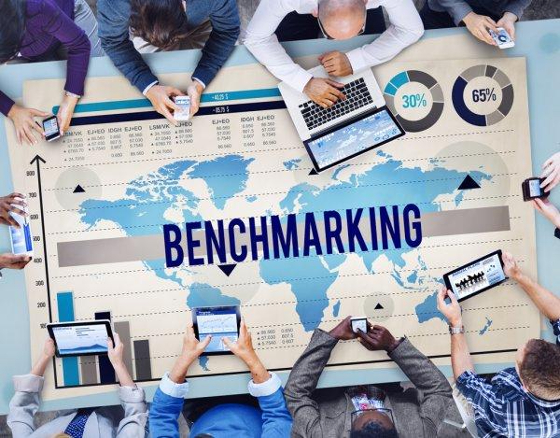The International Trade Blog International Sales & Marketing
Growing Your Export Sales Through Benchmark Assessments
On: November 1, 2021 | By:  Tony Kramer |
5 min. read
Tony Kramer |
5 min. read
 Business leaders are constantly searching for ways to improve their businesses, often using the continuous improvement process to help achieve this objective. Benchmarking can be an important component of continuous improvement, particularly if personnel at all levels and across all functions of the company are involved in the process.
Business leaders are constantly searching for ways to improve their businesses, often using the continuous improvement process to help achieve this objective. Benchmarking can be an important component of continuous improvement, particularly if personnel at all levels and across all functions of the company are involved in the process.
Have you considered benchmarking with a focus on exports and globalization? The point of benchmarking is to identify internal opportunities for improvement across a range of processes and functions. But, how often does company leadership benchmark the company’s operations and strategies against best practices for accelerating success in global markets, globalizing its organization and globalizing its vision and strategies?
Why Do It?
Many industries are global and most companies need to compete with domestic and international competitors. If company leadership does not develop and instill a global perspective, they will likely be surpassed by competitors who do. Benchmarking is defined as “a process of measuring the performance of a company's products, services or processes against those of another business considered to be the best in the industry, aka best in class." What better way to trigger innovation, learn from other industry sectors and gain information that will enable the company to become more successful globally.
What Should Be Benchmarked?
The key to successful benchmarking is to clearly understand the processes, procedures and methods that allow a company to become the best across a wide range of categories. Initially, it will be important to establish baseline information about your company. This information will provide a snapshot of your organization in relation to factors that are associated with success in international markets. It also initiates the product assessment process and examines business reasons for entering and expanding into export markets.
A comprehensive Export and Globalization Benchmark Assessment should include an Operational Benchmark Assessment and a Strategic Benchmark Assessment.
The Operational Benchmark Assessment
The Operational Assessment would benchmark all aspects of the company’s operations against best-practice standards, including:
- Company and management
- Products
- Markets and entry /expansion methods
- Operational plan and budget
- Organization, policies and systems
- Information and resources
- Export team and support services
- Competitive market price and offer
- Market entry and expansion preparation
- Production capacity
- Distribution network
- Sales and financing
- Shipping and collections
- The evaluation process
Let’s use a real-life example to take a closer look at operational benchmarking. The company is a mid-size producer of hand tools. They benchmarked 39 subsets under the Operational Assessment categories listed above. One subset of company and management was management commitment. The best practice standard was as follows: “Management has allocated a portion of its time to the export market entry and expansion effort sufficient to lead the effort and has designated a strategic international leader to guide the company-wide export acceleration and globalization process.”
The leadership team went through a very deliberate process to address areas of strength and areas of weakness. They engaged in discussion and sought input from others. They discovered that the time and guidance allocated to the international effort by the strategic international leader was significant. However, the international expansion effort was a low priority for the leadership as a whole. Management’s focus on domestic priorities was very high and on-going product issues further complicated the allocation of management time and leadership for the international expansion effort.
Based on their findings, they gave themselves a score of 5 on a scale of 1 to 10. They detailed their decisions and actions to be taken, assigned responsibilities and established a timeline for implementation and reassessment.
Other operational areas where the company scored 5 or less included after-sales product support; target market sales projections; integration of the domestic and international operational plan; organizational structure; intra-company coordination to implement the global expansion plan; access to information resources; selection of distribution channels in each target market; pricing and terms of sale for each target market; distribution partners (recruitment, selection and start-up in target markets); sales negotiations; integrating export-related policies, procedures and systems into the company’s standard operations; shipping and documentation system; and establishing and evaluating sales and profits by country and product line.
In each case, the company developed and implemented measures to move in the direction of established best practices, as well as a timeline for implementation and reassessment. The importance of making this a company-wide effort cannot be over-emphasized.
The Strategic Benchmark Assessment
Next, our hand tools company needed to take on a task that was even more challenging than the Operational Benchmark Assessment: the Strategic Benchmark Assessment. Below is a brief summary of the tasks:
- Profiling the industry’s strategic global players, strategic global market segments, strategic global country markets and strategic global competitors to understand the company’s role or position in the global environment.
- Assessing industry globalization forces such as market forces, cost forces, government forces, competitive forces and other current or future globalization forces to understand key conditions that are propelling the globalization of the industry.
- Assessing the extent to which the company’s strategies are globalized to be in balance with the industry’s globalization force including assessing and benchmarking the company’s strategies related to market participation, product standardization, activity location, marketing and competitive moves.
- Globalizing the company’s strategic direction including the future strategic product and market direction it will pursue and the future strategic competencies it will need to achieve to reach maximum profitability and growth and strategic competitive advantage in the global market of the future.
- Globalizing the strategic plan including strategic goals, initiatives, values and mission to integrate its domestic and global strategies into a single globalized strategy.
This was their first attempt to consolidate and document their knowledge about the company in relation to the global industry and then compare those findings with best practices. They benchmarked 17 subsets under the Strategic Benchmark Assessment tasks listed above. On a scale of 1 to 10, the company scored between 2 and 5 on those ratings.
On the downside, there was a lot they didn’t know, and they had a lot of work to do. The upside was that they saw the value of initiating an ongoing process to collect information that would help them become more competitive and more profitable.
Who Does It and How Often?
Many companies bring in someone from the outside, such as a management consultant, to conduct benchmark assessments. However, you may want to consider conducting the Export and Globalization Benchmark Assessment as an internal initiative. Depending on your company’s global experiences, you may find some of the tasks more or less difficult. Frequently you will find that you do not have information adequate to make a firm decision or that your judgments are somewhat tentative. Initially, you will use your knowledge, experience and immediately available resources to work through the various components of the assessment.
Over time, the questions raised during this initial pass will be revisited and increasing amounts of knowledge, experience and resources will be brought to bear and your decisions and judgments will be updated. As mentioned earlier, getting personnel across all functions and at all levels involved in the process will be critical to success in terms of contributing information, ideas and ultimately buy-in for decisions, changes and plans that result from the benchmarking.
Like what you read? Subscribe today to the International Trade Blog to get the latest news and tips for exporters and importers delivered to your inbox.

About the Author: Tony Kramer
Tony is CEO of FasTrack Global Expansion Solutions and a serial entrepreneur. He started up and successfully launched three technology companies prior to joining FasTrack. Tony is also the founder of Spark Labs, a technology-consulting firm that designs, develops and executes innovative software solutions for firms anywhere from startup to Fortune 500 companies. He started his career with positions at Pfizer and Ecolab. Tony earned his B.S. from the University of Minnesota and a M.S. in Chemical Engineering from the University of Connecticut.



